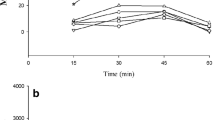Summary.
Morphine has long been known to have potent effects on body temperature. It has been suggested that both N-methyl-D-aspartate (NMDA) receptors and nitric oxide (NO) pathway are involved in thermoregulation and also known to play important roles in some of morphine effects. The aim of this study was therefore to investigate the contribution of NMDA receptors and NO to the thermoregulatory effect of morphine. Morphine produced a hypothermic effect, especially at the dose of 10 mg/kg. Ketamine (5–40 mg/kg, i.p.) and NG-nitro-L-arginine-methyl ester (L-NAME, 1–100 mg/kg, i.p.) also produced hypothermic effects with their higher doses. At doses which themselves produced no effect on colonic temperature in mice, both ketamine (10 mg/kg, i.p.) and L-NAME (10 mg/kg, i.p.) enhanced the hypothermic effect of morphine (10 mg/kg, i.p.). These results further support the relationship between NO and NMDA receptors and suggest a possible role of NMDA-NO pathway in the thermoregulatory effect of morphine.
Similar content being viewed by others
Author information
Authors and Affiliations
Additional information
Received August 4, 1999; accepted October 6, 1999
Rights and permissions
About this article
Cite this article
Ulugol, A., Dost, T., Dokmeci, D. et al. Involvement of NMDA receptors and nitric oxide in the thermoregulatory effect of morphine in mice. J Neural Transm 107, 515–521 (2000). https://doi.org/10.1007/s007020070074
Issue Date:
DOI: https://doi.org/10.1007/s007020070074




